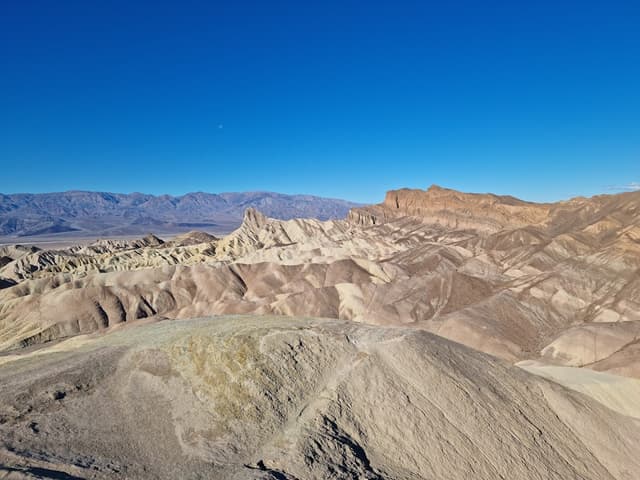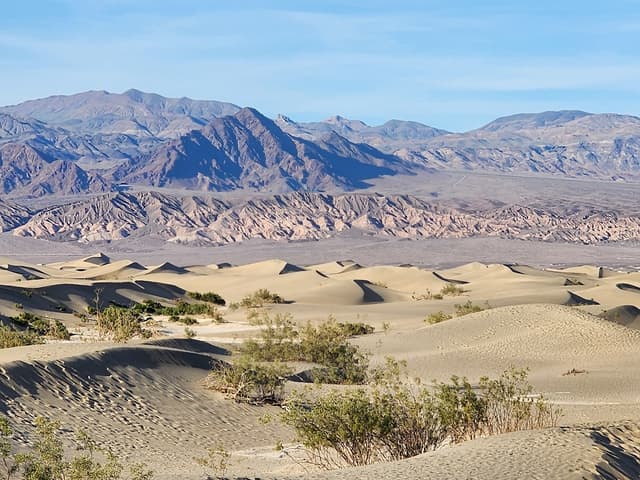Introduction
Death Valley is the largest US national park outside of Alaska. It is also the hottest, driest, and lowest national park. We did not think there would be much to see or do here, and were pleasantly surprised by the park’s diversity and everything it had to offer to visitors. Death Valley is a land of extremes where you can find large sand dunes, colorful sandstone mountains, below sea-level salt flats, wildflowers, oases, and even snow in certain months. It is definitely worth doing a day trip through the park — every turn offers a unique landscape. Your first stop should be the Furnace Creek Visitor Center where you can get information about the park’s history, the day’s weather, and trail conditions. It is also a good place to pick up some food and water for the day.
Because this day trip was on our way to Lake Tahoe from Las Vegas, we entered the park through the east side near Death Valley Junction and exited from the northwest towards Panamint Springs. If you also choose to drive in from the east, you can stop at Zabriskie Point before heading to Furnace Creek as it is on the way. The route we took is outlined below, but you can add stops such as Dantes View, Devil’s Golf Course, Golden Canyon, and Ubehebe Crater.
Day Trip Itinerary
ZABRISKIE POINT
Start the day’s sightseeing at Zabriskie Point and enjoy the view of the surrounding badlands. Zabriskie Point is part of the Amargosa Range and is made up of sediment from Furnace Creek Lake that dried up over 5 millions years ago. There is a fairly large parking lot where you can leave your car and walk around on designated trails to enjoy the landscape from different angles. This is a popular spot for sunrise and sunset.

BADWATER BASIN
After Zabriskie Point, head to Badwater Basin for a picnic on the salt flats. Be sure to also pack a hat, lots of water, and sunscreen — especially if you are visiting in the summer. Badwater Basin is a large salt flat that sits 282 feet below sea level. It is home to the lowest point in North America and is known for its unique salt formations, in the shape of a polygon, that appear to stretch on for miles. The salt flat is about a quarter-mile walk from the parking lot.

ARTIST DRIVE & ARTIST'S PALETTE
Head back the way you came, but make a right-hand turn onto the 9-mile long Artist Drive. This is an impressive one-way road that cuts through some mountains and cool rock formations. The drive reminds me of a rollercoaster with its many turns and dips that offer unique views. Roughly 5 miles into the drive, you will reach Artist’s Palette — a hillside known for its palette-like appearance. The many colors were produced by the oxidation of minerals and volcanic ash over millions of years. You can park your car here and hike to get a closer look.

MESQUITE FLAT SAND DUNES
You have probably seen the Mesquite Flat Sand Dunes before — given their proximity to Los Angeles, these dunes have been featured in several movies including Star Wars. Less than 1% of the desert in Death Valley is covered with dunes. The Mesquite Flat Sand Dunes are is the largest dune field in the park. These dunes are the best known and most accessible in Death Valley.

Logistics
HOW TO GET THERE
You will need to use your own car or rent a car to explore Death Valley as there is no public transportation available. It is roughly a 2 hour drive from Las Vegas and a 4.5 hour drive from Los Angeles. It's also a 3 hour drive from Mammoth Lakes. Information about how to get to the park as well as park maps can be found on the National Park Service website.
ENTRANCE FEES
Vehicle Entrance Fee: $30 for 7 Days. This permit allows all persons traveling with the permit holder in one single private, non-commercial vehicle (car/truck/van) to leave and re-enter the park as many times as they wish during the 7-day period from the date of purchase.Motorcycle Entrance Fee: $25 for 7 DaysIndividual Entrance Fee: $15 for 7 Days. This permit allows a single individual traveling on foot or bicycle to leave and re-enter the park as many times as they wish during the 7-day period from the date of purchase.Death Valley Annual Pass:$55 for one year. Annual pass providing free entrance to Death Valley for 12 months from the date of purchase.
BEST TIME TO VISIT
Most visitors to the park choose to go in the Spring or Fall months as the temperature is more tolerable than in the summer months. In addition the the warm and sunny days, the chances of seeing wildflowers is higher in the spring. However, this season is the most crowded. Check out the National Park Service website to help you decide what time of year to visit.
The home for unique & authentic travel